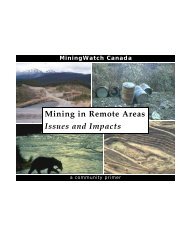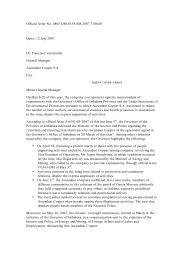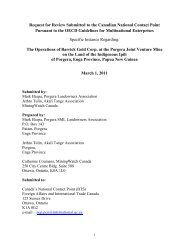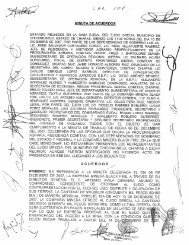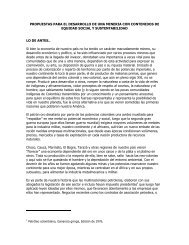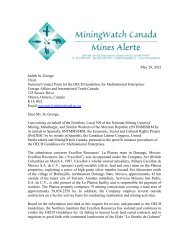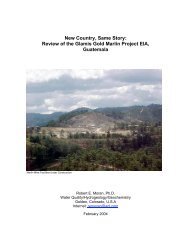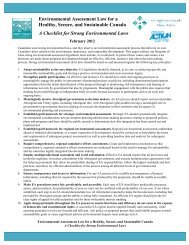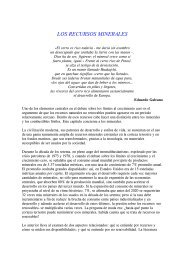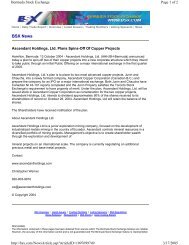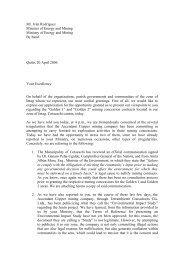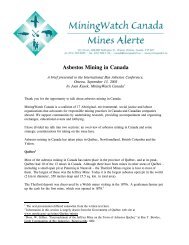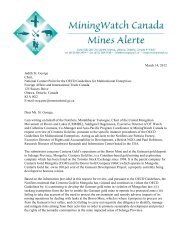Environmental Aspects of Phosphate and Potash Mining
Environmental Aspects of Phosphate and Potash Mining
Environmental Aspects of Phosphate and Potash Mining
- No tags were found...
You also want an ePaper? Increase the reach of your titles
YUMPU automatically turns print PDFs into web optimized ePapers that Google loves.
<strong>Environmental</strong> <strong>Aspects</strong> <strong>of</strong> <strong>Phosphate</strong> <strong>and</strong> <strong>Potash</strong> <strong>Mining</strong>1. Introduction1.1 The <strong>Mining</strong> <strong>of</strong> <strong>Phosphate</strong> Rock<strong>and</strong> <strong>Potash</strong> <strong>and</strong> the EnvironmentFigure 1.1World mineral fertilizer productionFertilizers are a key factor in sustaining the world'sagricultural output. They supply nutrients that areneeded by all plants for normal growth, development<strong>and</strong> health. Maintaining an adequate supply <strong>of</strong> foodfor human consumption requires: A supplementary source <strong>of</strong> plant nutrients if thenatural supply is insufficient. Replacement <strong>of</strong> the many possible nutrient losses.Ammonia<strong>Phosphate</strong>rock<strong>Potash</strong>Million tonnes nutrients12010080604020These replacement <strong>and</strong>/or supplementary suppliescan be provided through organic manures <strong>and</strong>/ormineral fertilizers.1990 to 20000This publication concerns the provision <strong>of</strong> raw materialsfor two important mineral fertilizers, phosphate<strong>and</strong> potash.Three major nutrients are required in large quantitiesfor plant growth, nitrogen, phosphorous <strong>and</strong> potassium.Three secondary nutrients are required in smallerquantities on some soils; sulfur, calcium <strong>and</strong> magnesium.Seven micronutrients may be required in smallamounts where deficient. Each nutrient has a specificbiological function <strong>and</strong>, while there may be synergiesbetween the nutrients, none has a substitute.By far the most important for the present publication,in terms <strong>of</strong> the quantity mined <strong>and</strong> potential impacton the environment, are phosphate <strong>and</strong> potash.The production <strong>of</strong> phosphorous <strong>and</strong> potassium mineralfertilizers relies essentially on the mining <strong>of</strong>mineral concentrations, in the form <strong>of</strong> ore depositsfrom the earth's crust. Nitrogen mineral fertilizers, onthe other h<strong>and</strong>, are almost entirely based on ammoniamanufactured from the abundant source <strong>of</strong> atmosphericnitrogen, water <strong>and</strong> energy.The production <strong>of</strong> nitrogen fertilizers has been discussedextensively in the earlier publication byUNEP/UNIDO/IFA on ‘Mineral Fertilizer Production<strong>and</strong> the Environment: Part 1 - The Fertilizer Industry'sManufacturing Processes <strong>and</strong> <strong>Environmental</strong> Issues’<strong>and</strong> will not be covered further here.World production <strong>of</strong> phosphorous <strong>and</strong> potassiummineral fertilizers in 1998/99 was 34 Mt P 2 O 5 (1) <strong>and</strong>25.5 Mt K 2 O respectively. This required the extraction<strong>of</strong> 144 Mt <strong>of</strong> phosphate rock <strong>and</strong> more than 45 Mt <strong>of</strong>potash ore (2). Table 1.1 indicates the scale <strong>of</strong> the mineralfertilizer raw material mining industry incomparison to the mining <strong>of</strong> other bulk mineral <strong>and</strong>energy commodities.Table 1.1.Comparison <strong>of</strong> the World Production <strong>of</strong> SomeBulk Minerals in 1998/99ProductTonnageCoal 4,655,000,000Iron Ore 1,020,000,000Salt 186,000,000<strong>Phosphate</strong> Rock 144,000,000Bauxite 126,000,000Gypsum 107,000,000<strong>Potash</strong> Ore (2) 45,000,000(1) <strong>Phosphate</strong> <strong>and</strong> potash may be expressed as their elementalforms P <strong>and</strong> K, or as oxide forms P 2 O 5 <strong>and</strong> K 2 O. In thispublication the oxide form is used.Mt = million tonnes(3) In KCl equivalent (sylvinite). Actual tonnages are larger,including kieiserite, langbeinite <strong>and</strong> carnallite ore.



